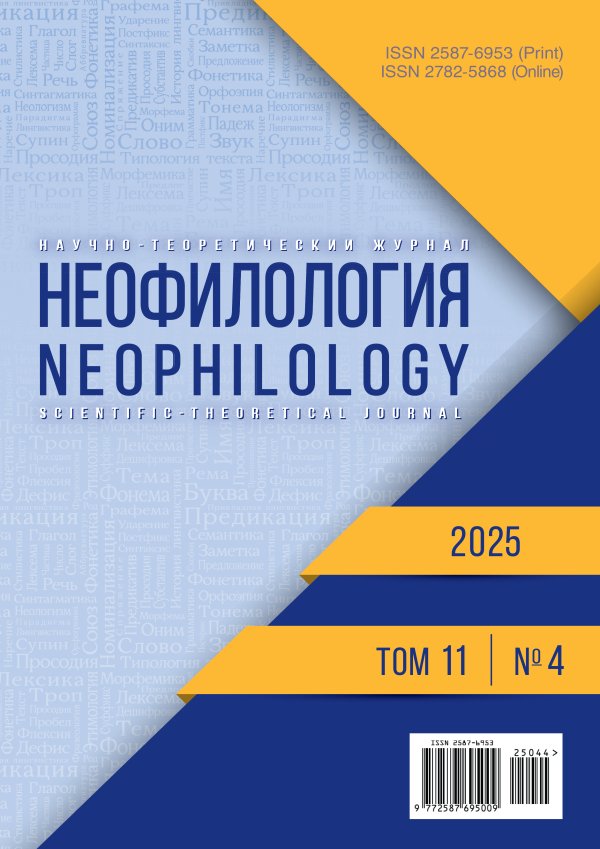Когнитивно-прагматический подход к интерпретативной репрезентации
- Авторы: Фурс Л.А.1
-
Учреждения:
- ФГБОУ ВО «Тамбовский государственный университет им. Г.Р. Державина»
- Выпуск: Том 11, № 1 (2025)
- Страницы: 21-30
- Раздел: ПАРАДИГМЫ ЯЗЫКОЗНАНИЯ И СОВРЕМЕННАЯ ЛИНГВИСТИКА
- URL: https://journal-vniispk.ru/2587-6953/article/view/295471
- DOI: https://doi.org/10.20310/2587-6953-2025-11-1-21-30
- ID: 295471
Цитировать
Полный текст
Аннотация
ВВЕДЕНИЕ. Целью исследования является когнитивно-прагматический подход к изучению процессов интерпретативной репрезентации в английском языке.
МАТЕРИАЛЫ И МЕТОДЫ. Методы исследования включают когнитивный анализ, семантический анализ, дискурсивный анализ и метод инференциального анализа. Мы также предлагаем метод когнитивного моделирования для визуального представления модели интерпретативной обработки информации. Материалом исследования являются выборки примеров из аутентичных английских словарей и онлайн-ресурсов.
РЕЗУЛЬТАТЫ ИССЛЕДОВАНИЯ. Анализ данных показал, что значительная часть информации может быть представлена косвенно, что приводит к скрытым ассоциациям и оценочным инференциям. Исследование показало роль таких механизмов в процессах интерпретативной репрезентации, как механизм расширения смысла, механизм оппозиции, механизм дублирования, механизм подмены понятий и механизм ассоциативных импликаций, а также роль синтаксических конструкций в представлении различных интерпретаций. Среди них выделены конструкции с межличностными парантезами, квазипридаточные конструкции, синкретические конструкции, конструкции с фразеологизмом, двусмысленные комплименты, тавтологические конструкции, а также конструкции с концептуальными метафорами, концептуальными метонимиями и концептуальными сравнениями.
ЗАКЛЮЧЕНИЕ. Сделан вывод, что процесс интерпретативной репрезентации является сложным и многомерным, однако привлечение когнитивно-прагматического подхода позволяет раскрыть комплексный характер информации и интерпретировать скрытые смыслы, а также вывести все оценочные ассоциации.
Об авторах
Л. А. Фурс
ФГБОУ ВО «Тамбовский государственный университет им. Г.Р. Державина»
Автор, ответственный за переписку.
Email: Liudmila.furs@gmail.com
ORCID iD: 0000-0003-0353-748X
доктор филологических наук, профессор, профессор кафедры зарубежной филологии и прикладной лингвистики
Россия, 392000, Российская Федерация, г. Тамбов, ул. Интернациональная, 33Список литературы
- Grice P. Logic and conversation. In: Speech Acts, Syntax and Semantics. New York, Academic Press, 1975, pp. 41-58. https://doi.org/10.1163/9789004368811_003
- Searle J.R. Indirect speech acts. In: Syntax and Semantics. Speech Acts. New York, Academic Press, 1975, pp. 59-82. https://doi.org/10.1163/9789004368811_004
- Wilson D., Sperber D. Representation and relevance. In: Mental Representations: The Interface Between Lan-guage and Reality. New York, Cambridge, Cambridge University Press, 1988, pp. 133-153.
- Furs L.A. Irregular loading of sentence meaning: a cognitive-pragmatic view. Journal of Siberian Federal Uni-versity. Humanities and Social Sciences, 2023, vol. 16, no. 6, pp. 953-961. https://elibrary.ru/qmpvqc
- Kubryakova E.S. Correlation between language and world and its link to the notion of knowledge. Cognitive Studies of Language, 2008, vol. 3, pp. 11-24. (In Russ.) https://elibrary.ru/pnolwt
- Boldyrev N.N. Anthropocentric nature of language in its functions, units, and categories. Issues of Cognitive Linguistic, 2015, no. 1 (42), pp. 5-12. (In Russ.) https://elibrary.ru/thiswp
- Langacker R.W. Assessing the cognitive linguistic enterprise. In: Cognitive Linguistics: Foundations, Scope, and Methodology. Berlin, New York, Mouton de Gruyter, 1999, pp. 13-59. https://doi.org/10.1515/9783110803464.13
- Croft W., Cruse D.A. Cognitive Linguistics. Cambridge, Cambridge University Press, 2004, 356 p. https://doi.org/10.1017/CBO9780511803864
- Furs L.A. Subjective interpretation in syntax: How the mind structures reality. Proceedings of the Philological Readings “European Proceedings of Social and Behavioural Sciences”. London, EPSBS Publ., 2020, pp. 39-47. https://doi.org/10.15405/epsbs.2020.04.02.5, https://elibrary.ru/kmpohy
- Talmy L. Atttention Phenomena. In: The Oxford Handbook of Cognitive Linguistics. Oxford, Oxford University Press, 2007, pp. 264-293. https://www.academia.edu/44077776/THE_OXFORD_HANDBOOK_OF_COGNITIVE_LINGUIS
- Talmy L. Semantics. In: Semantics: An International Handbook of Natural Language Meaning. Berlin, Walter De Gruyter, 2011, vol. 1, pp. 622-642.
- Lakoff G., Johnson M. Metaphors We Live By. Chicago, University of Chicago Press, 1980, 256 p. https://books.google.ru/books?id=iyZgQgAACAAJ&hl=ru&source=gbs_navlinks_s
- Lakoff G., Turner M. More than Cool Reason: a Field Guide to Poetic Metaphor. Chicago, University of Chica-go Press, 1989, 230 p. https://doi.org/10.7208/chicago/9780226470986.001.0001
- Furs L.A. Interaction of cognitive and metacognitive levels in the formation of complex knowledge. Issues of Cognitive Linguistics, 2018, no. 2 (55), pp. 74-78. (In Russ.) https://doi.org/10.20916/1812-3228-2018-2-74-78, https://elibrary.ru/yvjdlk
- Furs L.A. Cognition and cognitive dynamics. Issues of Cognitive Linguistics, 2021, no. 3, pp. 52-58. (In Russ.) https://doi.org/10.20916/1812-3228-2021-3-52-58, https://elibrary.ru/ltyqvq
Дополнительные файлы











